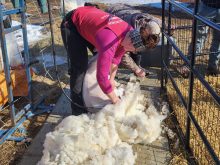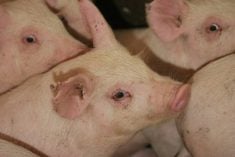OKOTOKS, Alta. – After dogs, goats might be man’s next best friend.
For exhibitors at the West National dairy goat show at Okotoks, raising goats is a labour of love whether they are leading out the floppy eared Nubian or the nearly earless LaMancha.
There were more than 100 entries representing five breeds for the show held last month.
The other breeds were Alpine, Saanen and Toggenburg.
There are few goat shows offered so this is a premier event for goat enthusiasts in the four western provinces.
Read Also

Charges laid after cattle theft
Saskatchewan RCMP lay two charges against a man after six cattle went missing.
Most of the exhibitors keep the goats as a hobby but are serious about breeding for quality as well as cheese, yogurt and milk production. Many owners adopted goats when they were children.
Catherine Albertson of Maple Ridge, B.C., started raising goats as a 4-H member.
Today, the 21 year old is a licensed judge and owns about 30 LaMancha goats. She spends nearly two hours per day milking the does and the family uses the milk for her brother, who is lactose intolerant.
“My very first goat was a Nubian. I got it as a gift,” she said.
Danin Brown of Fort Macleod, Alta., has raised goats since she was eight years old when she received two kids as a gift. Now she leads champion quality Nubians into the ring.
For serious purebred goat breeders like Brown, the last two years have been difficult because they cannot import or export breeding stock to freshen their herds.
She was importing breeding stock from the United States and managed to get five across the line before the border closed due to BSE in May 2003. Other purchases were stranded in the U.S.
“We got caught in limbo,” she said.
Toggenburg breeder Leila Cranswick of Okotoks agrees goat breeders have been frustrated with the ongoing trade disputes affecting their animals. They have difficulty getting meat processed because cattle and sheep edge them out of the limited number of packers willing to handle goats. And, they have trouble getting new breeding stock.
“With the border being closed we can’t go either way so we have a very limited gene pool,” she said.
Goats and dogs were the first animals to be domesticated about 10,000 years ago. Goats are raised in nearly all regions of the world for milk, meat, hides and fibre.
Goat meat, called chevon, is eaten more than any other red meat worldwide and about half the world’s population drinks goat milk.
The Toggenburg goat is the oldest registered breed of any animal in the world, with records tracing back to the 1600s in Switzerland. It is a chocolate coloured goat with white patches on its face.
The Nubian is probably the most popular dairy breed. It has long, wide pendulous ears, a roman nose and can be almost any colour. The Nubian breed originated in the United Kingdom.
LaManchas were developed in the United States from a Spanish breed that was crossbred with other breeds. It is distinguished by having short ears.
The Saanen originated in Switzerland. A white breed, the does are heavy milk producers and usually yield three to four percent milk fat.
The Alpine originated in the French Alps. Colour ranges from pure white through shades of fawn, grey, brown, black, red, buff, piebald or various combinations of these colours. They have erect, medium-sized ears and the beard of males is pronounced.

















